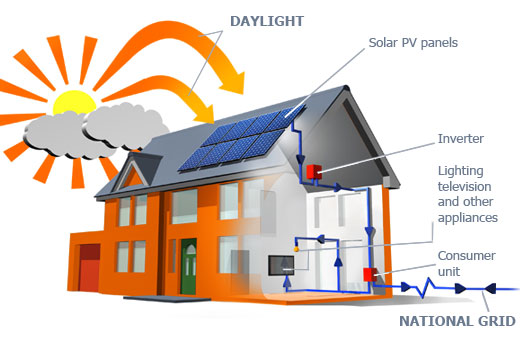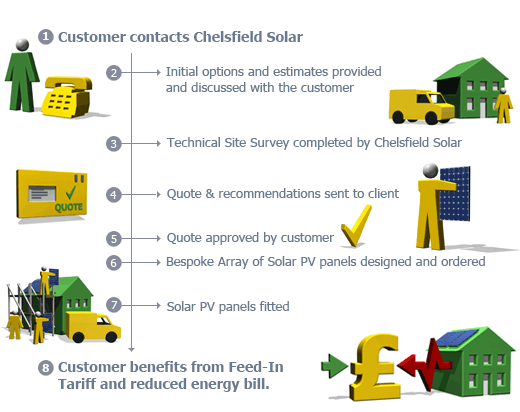Overview of a typical solar PV panel installation
Our aim is to make the process from initial enquiry through to installation and project completion as smooth, easy and stress free as possibleThe diagram below shows how a solar PV system works in a typical domestic installation project:

Chelsfield Solar install grid-connected solar electric systems for domestic, commercial and community projects. We advise on the best solution, provide a fully inclusive quote and help you with enrolling in the government Feed-in-Tariff scheme.
Solar PV systems can be installed on pitched or flat, preferably un-shaded, roofs or can be ground mounted. Typically though, the PV panels are secured on a southerly facing pitched roof aspect. Roofs that are orientated towards east-west still work well albeit with a reduced output (please note it is not recommended to have solar PV installed on a north facing roof). The solar PV panels are connected to an inverter, which converts electricity from DC to useable AC, and this is normally situated in the loft area or cupboard space. You will then have one cable from the inverter to the fuse board area, which is routed in the most inconspicuous way possible. With a solar PV system, the solar generated electricity is used at the time of generation first by any electrical appliances that require electricity at that time. If the PV system is generating more electricity than your property requires then the excess is automatically exported to the National Grid. If the PV system is not producing enough electricity to cover your usage then any additional is pulled from the National Grid in the normal way.
Selling your electricityThe government has a Feed-in Tariff scheme whereby you will receive a payment for solar PV generated electricity. The scheme is run for 20 years from the schemes introduction, the Feed-in Tariff rate is indexed linked and the income is tax-free for domestic customers. The amount paid is for everything generated irrespective of whether it is used at the time or not. You will also be paid for electricity exported back to the National Grid. In addition, you will also save by not importing electricity from your supplier if you use the solar PV electricity at the time of generation, which future proofs against rising energy prices. Please visit our Latest Tariffs page to find out more about the Feed-In-Tariffs. Electrical
The electrical component of the installation is covered by Part P of the Building Regulations. Chelsfield Electrical Ltd (parent company of Chelsfield Solar) are NIC/EIC approved contractors, which means we will arrange Building Control Part P approval on your behalf. Structural
The structural side of Building Regulations (Part A) relates to the weight, which is to be added to the roof in comparison to the weight of the roof covering. Following a site survey, we carry out a basic calculation of this ratio to check the system is within the relevant guideline. However, if you have any concerns you should contact the council building control department or an independent structural surveyor. Process
The diagram below explains the process of how we help you obtain the right solar PV panel system for your own property.

For a comprehensive understanding of solar PV visit our Guide to Solar and if you have any queries simply Contact Us for a no obligation estimate for your project.
